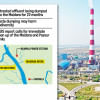Coal-fired power plants and related stories

Rampal is happening. That's pretty much the key message that we're getting from those concerned.
Which means, there is perhaps no point in discussing why Rampal would be a mistake. And, if we do, we will be put in the same box as those 'against development and progress'.
But, let's not, by creating false dichotomies, minimise the complexities and nuances that surround all of these issues.
The problem with the good people of the world is that they think everyone else is good, too. They don't need to come together. They don't need collective action. They merely exist. Until, perhaps, there is a crisis.
And a crisis we have. One that is as close to an existential crisis as we ever have seen (since independence,) notwithstanding the threat of earthquakes. [Hyperbolic? Yes, but only in the short run.]
That crisis is Rampal.
Not only because the Sundarbans are at stake (even though that's reason enough in and by itself as well).
Some thoughts and questions, not completely considered, because this conversation must go on.
One
Let's call it what it is: a breach in social justice.
Specifically, this is the making of environmental injustice that will imminently lead to inequity in health, or, in other words: health injustice.
How do I know this? Because:
1) Across the world, coal-fired power plants have supplied electricity to millions of people.
2) Across the same world, coal-fired power plants have polluted the soil via fly-ash fugitive dust deposition that has affected the local ecology, including the soil, with well-documented negative ramifications on humans in terms of respiratory, cardiovascular, neurologic, and reproductive health (Effect of occupation on lipid peroxidation and antioxidant status in coal-fired thermal plant workers, International Journal of Applied and Basic Medical Research).
Examples: In Delaware, USA, the Division of Public Health found that cancer was 17 percent higher than the rest of the nation, indicating a "cancer cluster" in the community in which the Indian River coal plant is based (Cancer cluster investigations in Delaware Health and Social Services, dhss.delaware.gov). In Chicago, USA, two coal plants, Fisk and Crawford plants, continue to cause respiratory problems among residents; about 350 people die every year due to the emissions from these plants (At the altar of coal fired plant, Huffington Post).
3) Recent research indicates that replacement of nuclear plants with coal-fired plants in the world would have the effect of 150,000 premature deaths per year (From nuclear power to coal power: Aerosol induced health and radiative effects. Journal of Geophysical Research: Atmospheres)
Two
We have to consider the land-mass of Bangladesh and the proximity of people and other life to coal-fired power plants.
Bangladesh is akin to a community in any large-sized country.
Bangladesh is the size of Wisconsin, one reasonably sized state in the United States.
So, when talking about carbon or greenhouse gas emissions and contribution to climate change, we need to talk about emission per square mile, not per capita.
Bangladesh is not an emitter. The per capita emission, given its population size, will never be that high.
But, given the land-mass, a large number of people – upwards of thousands – will be affected by such increases in the number of power plants, because proximity to the power plant will always be an issue.
Three
Yes. Additional supply of electricity will benefit those who are already marginalised: the poor. Perhaps even the poorest of the poor. Access to electricity will perhaps even mitigate many current health problems that marginalised groups experience. These groups include, I imagine, low-income individuals living in slum and other low-income areas across the rural-urban divide.
That means, they will have access to electricity-based modern technology, including, say, light, mobile telephones, television and media, agricultural technology, the whole gamut.
But, research indicates that they may slowly die of cancer. Or respiratory problems. Or cardiovascular problems. Or neurological problems.
I'm not convinced that's a great trade-off. It might be, of course. But, I need more convincing.
Four
Who will be at greatest risk?
The workers who will be employed at the plant.
Those claiming that Rampal will generate employment are not wrong. Not at all.
But, we must ask: at what personal cost? Who will bear the cost of their health? Who will be held personally responsible? Will there be doctors who can identify the symptoms of emission-exposure related health problems? Will there be treatments available for all workers? Local community members? Will their families be taken care of when they die? Will children born with birth defects directly related to exposure be cared for? By whom? Who will bear their responsibility? How will this intergenerational transmission of ill-health be stopped?
Five
And what of people who will be displaced by the power plant? Where will they go? How will they be rehabilitated?
Six
There is no such thing as clean coal. Coal is not clean. After all, koyla dhulay moyla jayna. It's not a proverb without meaning.
Just thought I'd put that out there.
Seven
If we believe in social justice, it means we believe in environmental justice. Reproductive justice. Health justice. And, economic justice.
Maybe Rampal makes economic sense. Maybe Rampal will ensure economic justice by creating employment and economic activity in the region. Economic justice may in turn foster other types of social justice – including reproductive justice and health justice, because it allows individuals to access health care, and engage in health behaviors.
But, if we counter these potential positive effects by placing these same people amidst elements that will negatively impact their health, and the health of future generations, it is not merely social injustice, it is a catastrophe.
A catastrophe that we can surely avoid.
The writing is on the wall.
Let's all read it.
The writer is Assistant Professor at the School of Social Work, University of Buffalo.

 For all latest news, follow The Daily Star's Google News channel.
For all latest news, follow The Daily Star's Google News channel. 








Comments